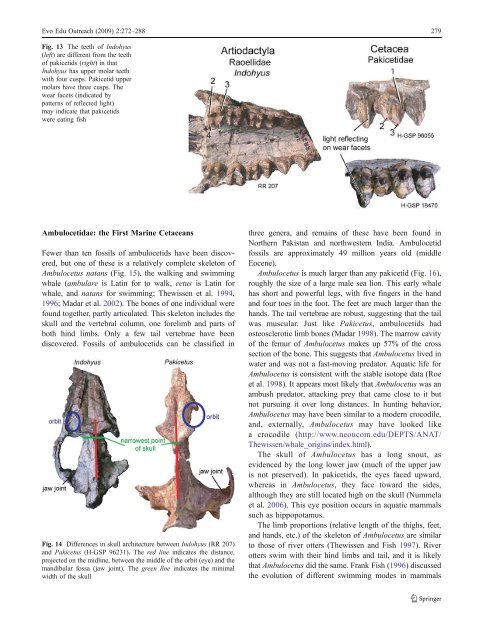From Land to Water: the Origin of Whales, Dolphins, and Porpoises
From Land to Water: the Origin of Whales, Dolphins, and Porpoises
From Land to Water: the Origin of Whales, Dolphins, and Porpoises
Create successful ePaper yourself
Turn your PDF publications into a flip-book with our unique Google optimized e-Paper software.
Evo Edu Outreach (2009) 2:272–288 279<br />
Fig. 13 The teeth <strong>of</strong> Indohyus<br />
(left) are different from <strong>the</strong> teeth<br />
<strong>of</strong> pakicetids (right) in that<br />
Indohyus has upper molar teeth<br />
with four cusps. Pakicetid upper<br />
molars have three cusps. The<br />
wear facets (indicated by<br />
patterns <strong>of</strong> reflected light)<br />
may indicate that pakicetids<br />
were eating fish<br />
Ambulocetidae: <strong>the</strong> First Marine Cetaceans<br />
Fewer than ten fossils <strong>of</strong> ambulocetids have been discovered,<br />
but one <strong>of</strong> <strong>the</strong>se is a relatively complete skele<strong>to</strong>n <strong>of</strong><br />
Ambulocetus natans (Fig. 15), <strong>the</strong> walking <strong>and</strong> swimming<br />
whale (ambulare is Latin for <strong>to</strong> walk, cetus is Latin for<br />
whale, <strong>and</strong> natans for swimming; Thewissen et al. 1994,<br />
1996; Madar et al. 2002). The bones <strong>of</strong> one individual were<br />
found <strong>to</strong>ge<strong>the</strong>r, partly articulated. This skele<strong>to</strong>n includes <strong>the</strong><br />
skull <strong>and</strong> <strong>the</strong> vertebral column, one forelimb <strong>and</strong> parts <strong>of</strong><br />
both hind limbs. Only a few tail vertebrae have been<br />
discovered. Fossils <strong>of</strong> ambulocetids can be classified in<br />
Fig. 14 Differences in skull architecture between Indohyus (RR 207)<br />
<strong>and</strong> Pakicetus (H-GSP 96231). The red line indicates <strong>the</strong> distance,<br />
projected on <strong>the</strong> midline, between <strong>the</strong> middle <strong>of</strong> <strong>the</strong> orbit (eye) <strong>and</strong> <strong>the</strong><br />
m<strong>and</strong>ibular fossa (jaw joint). The green line indicates <strong>the</strong> minimal<br />
width <strong>of</strong> <strong>the</strong> skull<br />
three genera, <strong>and</strong> remains <strong>of</strong> <strong>the</strong>se have been found in<br />
Nor<strong>the</strong>rn Pakistan <strong>and</strong> northwestern India. Ambulocetid<br />
fossils are approximately 49 million years old (middle<br />
Eocene).<br />
Ambulocetus is much larger than any pakicetid (Fig. 16),<br />
roughly <strong>the</strong> size <strong>of</strong> a large male sea lion. This early whale<br />
has short <strong>and</strong> powerful legs, with five fingers in <strong>the</strong> h<strong>and</strong><br />
<strong>and</strong> four <strong>to</strong>es in <strong>the</strong> foot. The feet are much larger than <strong>the</strong><br />
h<strong>and</strong>s. The tail vertebrae are robust, suggesting that <strong>the</strong> tail<br />
was muscular. Just like Pakicetus, ambulocetids had<br />
osteosclerotic limb bones (Madar 1998). The marrow cavity<br />
<strong>of</strong> <strong>the</strong> femur <strong>of</strong> Ambulocetus makes up 57% <strong>of</strong> <strong>the</strong> cross<br />
section <strong>of</strong> <strong>the</strong> bone. This suggests that Ambulocetus lived in<br />
water <strong>and</strong> was not a fast-moving preda<strong>to</strong>r. Aquatic life for<br />
Ambulocetus is consistent with <strong>the</strong> stable iso<strong>to</strong>pe data (Roe<br />
et al. 1998). It appears most likely that Ambulocetus was an<br />
ambush preda<strong>to</strong>r, attacking prey that came close <strong>to</strong> it but<br />
not pursuing it over long distances. In hunting behavior,<br />
Ambulocetus may have been similar <strong>to</strong> a modern crocodile,<br />
<strong>and</strong>, externally, Ambulocetus may have looked like<br />
a crocodile (http://www.neoucom.edu/DEPTS/ANAT/<br />
Thewissen/whale_origins/index.html).<br />
The skull <strong>of</strong> Ambulocetus has a long snout, as<br />
evidenced by <strong>the</strong> long lower jaw (much <strong>of</strong> <strong>the</strong> upper jaw<br />
is not preserved). In pakicetids, <strong>the</strong> eyes faced upward,<br />
whereas in Ambulocetus, <strong>the</strong>y face <strong>to</strong>ward <strong>the</strong> sides,<br />
although <strong>the</strong>y are still located high on <strong>the</strong> skull (Nummela<br />
et al. 2006). This eye position occurs in aquatic mammals<br />
such as hippopotamus.<br />
The limb proportions (relative length <strong>of</strong> <strong>the</strong> thighs, feet,<br />
<strong>and</strong> h<strong>and</strong>s, etc.) <strong>of</strong> <strong>the</strong> skele<strong>to</strong>n <strong>of</strong> Ambulocetus are similar<br />
<strong>to</strong> those <strong>of</strong> river otters (Thewissen <strong>and</strong> Fish 1997). River<br />
otters swim with <strong>the</strong>ir hind limbs <strong>and</strong> tail, <strong>and</strong> it is likely<br />
that Ambulocetus did <strong>the</strong> same. Frank Fish (1996) discussed<br />
<strong>the</strong> evolution <strong>of</strong> different swimming modes in mammals








